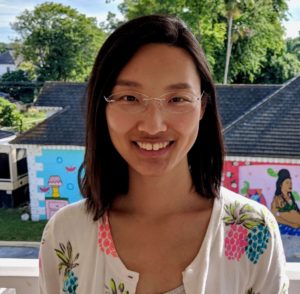Sirui Mi graduated from Colorado State University in Summer 2021, earning her master’s degree in food science and nutrition. Over the summer she worked as an intern with several different organizations focusing on community nutrition, food service management, and clinical nutrition. Learn more about her passion for community nutrition and food justice in the Q&A below.
Can you briefly introduce yourself?
I am originally from China and passionate about community nutrition and food justice. My hobbies include Zumba, cooking, and hiking with my husband and two dogs. I graduated in Summer 2021.
What attracted you to CSU?
My husband is an associate professor at CSU, and I had heard many good things about the graduate program in Food Science and Human Nutrition.
Why did you choose your field?
I discovered my passion for community nutrition and food justice when I worked as a project manager and international coordinator for a non-profit school that serves more than 600 migrant children in Beijing. Malnutrition is very prevalent in the migrant children population, and my experiences working with these children inspired me to find solutions to the problem.
So far, what has been your favorite experience at CSU?
My favorite experience at CSU is working with CSU Extension Nutrition specialist Jessica Clifford. Together, we designed and implemented a site-wide needs assessment to explore Coloradans’ nutrition and health needs.
How/why did you apply for your internship?
1200 hours of supervised practice rotations are required to become a Registered Dietitian. I applied for the internship through CSU’s Coordinated Master’s Program in Dietetics (CMPD). Dr. Sabo (CMPD program director) and Chris Rock (Internship and Practicum Coordinator) were extremely helpful in guiding me through the application process and connecting me with my preceptors.
What does an average day at your internship look like?
I had three internship rotations and my days looked very different for each different rotation.
- Community nutrition– Colorado Department of Public Health and Environment (CDPHE): My internship with CDPHE was 100% remote due to the COVID-19 pandemic. Instead of attending onsite discussions, I had multiple Google or Zoom meetings throughout the day to participate and learn from different public health nutrition initiatives at the local, state, and national levels. Outside of meetings, I conducted research projects for the Early childhood obesity prevention unit.
- Foodservice management– Poudre School District (PSD): My PSD rotation is half in-
 person and half online. I would usually check in with my supervisor at the beginning of each day to see the plan for the day. My daily tasks included making special diet menus, checking menu compliance, managing social media platforms, and designing nutrition education materials.
person and half online. I would usually check in with my supervisor at the beginning of each day to see the plan for the day. My daily tasks included making special diet menus, checking menu compliance, managing social media platforms, and designing nutrition education materials. - Clinical nutrition–Banner Health: My clinical rotation was 100% in-person. My days started with checking the patient list and prioritizing patients according to their nutrition score. My supervisor would let me know which patients I would see for the day. I would review patients’ medical and diet records in the system and talk to them one-on-one to do nutrition screening, follow-up, or nutrition education. Afterward, I would document patients’ information in the system to make it available to the multidisciplinary care team.
How are you applying what you’ve learned from your course of study to your current position?
The knowledge and skills I acquired from FSHN 525 Nutrition Education Theories and Practice came in handy for my CDPHE and PSD rotations. I applied the nutrition education principles to develop educational materials, such as tailoring to the audience’s literacy level, what fonts are easy to read, and how much white space is recommended to reserve for nutrition outreach materials. As a part of the graduate curriculum, we learned about biochemical, physiological, and molecular aspects of human nutrition. In my clinical rotation, I found that patients love to learn about the science behind their dietary restrictions as long as you can explain the science using approachable language. For example, most cardiac patients are advised to restrict their saturated fat intake to lower their LDL (the “bad” cholesterol). However, they often do not understand why LDL is bad and its connection to food. Using what I learned from Advanced Nutritional Science, I explained the science of patients’ dietary restrictions in plain language. I helped patients to make sense of their dietary restrictions and increase adherence.
What is the biggest lesson that you will take home from this experience?
The biggest lesson I learned is to be proactive. Interns are not always comfortable sharing their thoughts with preceptors, especially at the beginning of their rotations. I was initially reserved but was also eager to be recognized as a competent individual. I thought my preceptors would perceive some of my entry-level questions as nonconstructive and straightforward. Nevertheless, that was not the case. My preceptors welcomed all questions, appreciated and benefited from my outside-of-the-box thinking. Establishing a proactive working approach at an early stage was extremely meaningful for my professional development. This newly acquired skill-set has enabled me to optimize my learning experiences and, at the same time, encouraged me to contribute to the preceptors as much as possible.
What is next? What do you hope to accomplish in your career?
No matter which direction I go, I would like to dedicate my career to improving people’s quality of life through increasing food access and nutrition education, especially in under-served communities.
What advice do you have for incoming students?
Be flexible and think about what you can contribute instead of what you can get from the internship, this will help you in the long run.
The Department of Food Science and Human Nutrition is part of CSU’s College of Health and Human Sciences.
